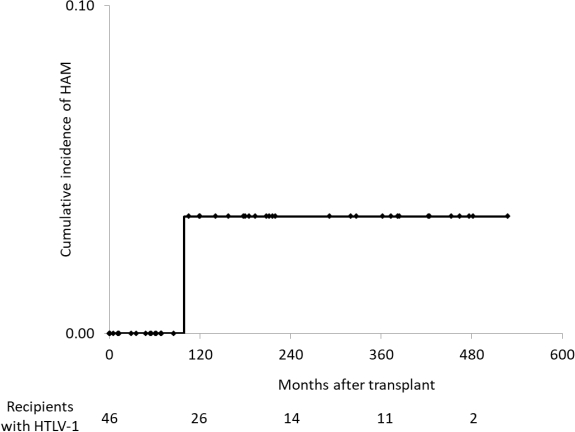Long-Term Outcome of Kidney Transplant Recipient with HTLV-1 Infection
N. Goto,1 M. Minami,1 K. Futamura,2 M. Okada,1 M. Tsujita,1 T. Hiramitsu,2 S. Narumi,2 Y. Watarai.2
1Nagoya Daini Red Cross Hospital, Transplant Nephrology, Nagoya, Japan
2Nagoya Daini Red Cross Hospital, Transplant Surgery, Nagoya, Japan.
Meeting: 2018 American Transplant Congress
Abstract number: A176
Keywords: Infection, Kidney transplantation, Outcome
Session Information
Session Name: Poster Session A: Kidney Transplant Goes Viral
Session Type: Poster Session
Date: Saturday, June 2, 2018
Session Time: 5:30pm-7:30pm
 Presentation Time: 5:30pm-7:30pm
Presentation Time: 5:30pm-7:30pm
Location: Hall 4EF
Background
The human T-lymphotropic virus (HTLV-I), which is endemic in southern Japan, is recognized as the cause of adult T cell leukemia-lymphoma (ATL) and HTLV-1-associated myelopathy (HAM). In general population, the cumulative lifetime risk of ATL and HAM is 5 and less than 2 percent, respectively. The onset of ATL is 20 to 30 years, while that of HAM is ranging from several months to 30 years after infection. There is no data on incidence of ATL or HAM long-term after kidney transplantation
Methods
The investigation was a retrospective cohort of kidney transplant recipients in a single center, Nagoya Daini Red Cross Hospital, Nagoya, Japan. Eligible recipients underwent consecutive kidney transplant between 1972 and 2017 (n=2601). The diagnosis of HTLV-I infection was based on antibody to the virus. It was screened by an enzyme-linked immunosorbent assay (ELISA), and then conformed by western blotting (WB). The study outcome was the occurrence of ATL or HAM with HTLV-1 infection which had occurred at the end of 2017.
Results
The number of recipients with HTLV-I infection before transplant was 46 (1.8%). Age at transplant was 41±13 (18–69) years. Thirty-three(72%) were males. Three received transplant from HTLV-1 infected donors. The median follow-up period censored by death or dialysis after transplantation was 5.7 (0-35.3) years. The median follow-up period censored by death was 12.5 (0-44) years.
The causes of death were 4 (36%) sepsis, 2 (18%) gastrointestinal bleeding, 2 (18%) hepatic failure, 1 (9%) cerebral hemorrhage, 1 (9%) abdominal aortic aneurysm rupture, and 1 (9%) myelodysplastic syndromes. One (2.2%) developed HAM in 8.3 years after transplant during graft survival. He died of invasive pneumococcal disease 2.5years after onset of HAM. No recipients with HTLV-I infection developed ATL during the follow-up period.
He died of invasive pneumococcal disease 2.5years after onset of HAM. No recipients with HTLV-I infection developed ATL during the follow-up period.
Conclusions
From this low incidence of ATL and HAM in long-term follow up, benefits of kidney transplantation in CKD patients with HTLV-1 may be the same as those without HTLV-1.
CITATION INFORMATION: Goto N., Minami M., Futamura K., Okada M., Tsujita M., Hiramitsu T., Narumi S., Watarai Y. Long-Term Outcome of Kidney Transplant Recipient with HTLV-1 Infection Am J Transplant. 2017;17 (suppl 3).
To cite this abstract in AMA style:
Goto N, Minami M, Futamura K, Okada M, Tsujita M, Hiramitsu T, Narumi S, Watarai Y. Long-Term Outcome of Kidney Transplant Recipient with HTLV-1 Infection [abstract]. https://atcmeetingabstracts.com/abstract/long-term-outcome-of-kidney-transplant-recipient-with-htlv-1-infection/. Accessed December 15, 2025.« Back to 2018 American Transplant Congress
